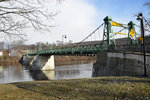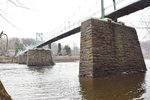


America’s most famous bridge-building family, the Roeblings, were based in New Jersey but did few projects in neighboring Bucks County.
Three Roebling-connected bridges in our county are easily accessible today, for people who want to see these engineering marvels.
John Augustus Roebling was the foremost bridge engineer of his time and the Roebling family set the standard for suspension bridges, from the Brooklyn Bridge to the Golden Gate Bridge.
A German immigrant, Roebling settled in western Pennsylvania in 1831 and moved to Trenton in 1848 at the suggestion of ironmaker Peter Cooper.
During its lifetime, the John A. Roebling’s Sons Company was Trenton’s largest employer, and it established a village south of Trenton, to support a steel mill. In 1952, the Roebling family sold its business to a competitor from Colorado; however, the Roebling influence on America was undisputed.
To John Augustus Roebling, bridges were an expression of an ideal that transportation should embrace beauty. After all, Roebling had been a star pupil of the philosopher Hegel back in Germany. In Bucks County, we have three examples of those ideals. Two bridges designed and built by John A. Roebling’s Sons sit over the Delaware River, and a third bridge, in the classic Roebling design, crosses a creek in a public park.
The Roebling Bridge in Riegelsville, Pa., solved a problem for a privately owned company that lost its covered bridge in the Pumpkin Flood of October 1903.
It hired the Roeblings, who dispatched their top engineer, Sebern A. Cooney, to Bucks County. Cooney’s design combines the former covered bridge’s river piers with the Roebling suspension-bridge system.
The result is a three-part suspension bridge topped with minarets. John Augustus Roebling had used a similar design for his Allegheny River Bridge in the 1850s. Today, the bridge remains open to limited road traffic with a 3-ton limit. Footbridges on each side of its 580-foot deck provide a beautiful river view.
About 15 miles down river from Riegelsville is Bucks County’ other Roebling-built bridge in Lumberville.
The pedestrian-only bridge crosses over to Bulls Island and Raven Rock in New Jersey, and it also provides an outstanding view of the Delaware River.
The Lumberville Bridge rests on large piers built for a covered bridge that once spanned the river. By 1945, a joint commission closed the covered bridge as unsafe. An inspection revealed severe damage caused by wood-boring worms.
The commission awarded a contract to the Roebling company for a stootbridge that opened in 1947. The 688-foot-long bridge received a major rehabilitation in 1993 and it also crosses over a canal.
The third Bucks County bridge with Roebling connections is the 1937 Lenape Park suspension footbridge in Perkasie.
The Roebling company had been selling pedestrian bridges and bridge parts for generations, and it published bridge calculations for use by civil engineers.
In 19 asked the Works Progress Administration for a bridge over the Perkiomen Creek as part of the WPA’s Lake Lenape project.
In February 1937, WPA civil engineer Alan G. Orr from New Britain, designed two Roebling-style suspension footbridges bridges linked by an artificial island. The caveat: the steel components had to be Roebling parts.
The footbridge opened in August 1937, supported by Roebling wire rope cables, suspension rods and anchors. Local workers built the stiffening trusses and the decks. Two sets of concrete towers, in the classic Roebling style, support the bridges in a beautiful setting.
It also important to remember these three historical landmarks are preserved by taxpayers.
The Delaware River Joint Toll Bridge Commission maintlle and Lumberville bridges using money from tolls, while Perkasie taxpayers pay for the footbridge’s upkeep with help from local volunteer groups. It is a small cost worth paying, to have part of the Roebling legacy in Bucks County.
Scott Bomboy is a local historian who has written extensively about covered bridges, among other topics. The Roebling Museum will be presenting a free extended Zoom program on this topic at 6 p.m.on Sept. 21, 2022. Registration is required at www.roeblingmuseum.org/events.
Join our readers whose generous donations are making it possible for you to read our news coverage. Help keep local journalism alive and our community strong. Donate today.